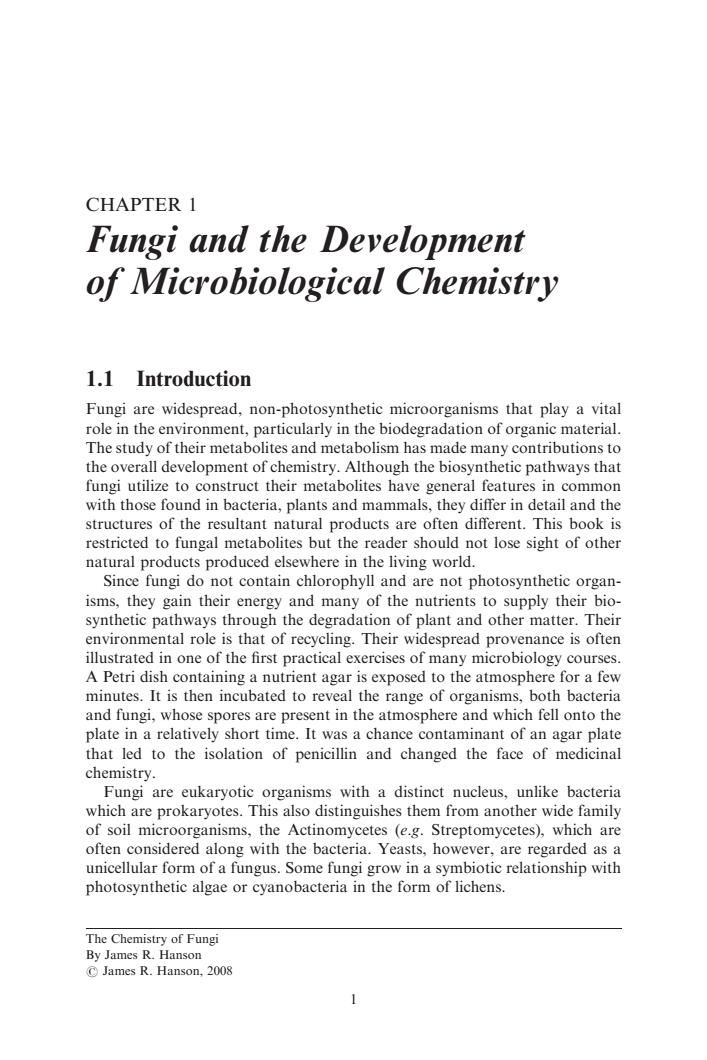正在加载图片...

CHAPTER 1 Fungi and the Development of Microbiological Chemistry 1.1 Introduction Fungi are widespread.non-photosynthetic microorganisms that play a vital role in the enviro 艺 The study of their me a etabolism ha le many the overall development of chemistry fungi utilize to construct their metabolites have general features in commor with those found in bacteria,plants and mammals,they differ in detail and the structures of the resultant natural products are often different.This book is restricted to fungal metabolites but the reader should not lose sight of other natural products produced elsewhere in the living world. Since fungi do not contain chlorophyll and are not photosynthetic organ- isms,they their energy and ma of the synthetic pat wa degradati of that of Their widespread provenanceisoften illustrated in one of the first practical exercises of many microbiology courses. A Petri dish containing a nutrient agar is exposed to the atmosphere for a few minutes.It is then incubated to reveal the range of organisms,both bacteria and fungi,whose spores are present in the atmosphere and which fell onto the plate in a relatively short time.It was a chance contaminant of an agar plate that led to the isolation of penicillin and changed the face of medicinal che mistry ungi are eukaryotic organisms with a distinct nucleus. unlike bacteria of soil microorganisms,the Actinomycetes (e.g.Streptomycetes),which are often considered along with the bacteria.Yeasts,however,are regarded as a unicellular form of a fungus.Some fungi grow in a symbiotic relationship with photosynthetic algae or cyanobacteria in the form of lichens. The Chemistry of Fungi CHAPTER 1 Fungi and the Development of Microbiological Chemistry 1.1 Introduction Fungi are widespread, non-photosynthetic microorganisms that play a vital role in the environment, particularly in the biodegradation of organic material. The study of their metabolites and metabolism has made many contributions to the overall development of chemistry. Although the biosynthetic pathways that fungi utilize to construct their metabolites have general features in common with those found in bacteria, plants and mammals, they differ in detail and the structures of the resultant natural products are often different. This book is restricted to fungal metabolites but the reader should not lose sight of other natural products produced elsewhere in the living world. Since fungi do not contain chlorophyll and are not photosynthetic organisms, they gain their energy and many of the nutrients to supply their biosynthetic pathways through the degradation of plant and other matter. Their environmental role is that of recycling. Their widespread provenance is often illustrated in one of the first practical exercises of many microbiology courses. A Petri dish containing a nutrient agar is exposed to the atmosphere for a few minutes. It is then incubated to reveal the range of organisms, both bacteria and fungi, whose spores are present in the atmosphere and which fell onto the plate in a relatively short time. It was a chance contaminant of an agar plate that led to the isolation of penicillin and changed the face of medicinal chemistry. Fungi are eukaryotic organisms with a distinct nucleus, unlike bacteria which are prokaryotes. This also distinguishes them from another wide family of soil microorganisms, the Actinomycetes (e.g. Streptomycetes), which are often considered along with the bacteria. Yeasts, however, are regarded as a unicellular form of a fungus. Some fungi grow in a symbiotic relationship with photosynthetic algae or cyanobacteria in the form of lichens. The Chemistry of Fungi By James R. Hanson r James R. Hanson, 2008 1